Elkhorn - Tour Diary
Follow psych folk duo Elkhorn around on their summer tour 2016 and learn about a Stonehenge of amps, a Jimi Hendrix bootleg and the places and people they met.
Thanks to Drew and Jesse for documenting their road trip.
Enjoy! ~ dfbm
Hudson, NY – Spotty Dog Bookstore
After a short drive north on I-87 in Jesse's navy blue Subaru Forester, we arrived on a warm August afternoon in the small town of Hudson. This was the first date of our first tour as Elkhorn, in support of a self-titled cassette that was being released that week on Beyond Beyond is Beyond Records. It had occurred to me that the first gig might be a throat-clearing performance, where we would have to get one out of the way before the music really took off, and that's exactly what it turned out to be. We only had time for a short practice before the show. Alexander Turnquist, our host and a talented guitarist, had graciously offered us the use of his practice space in an old brick school building that had been repurposed as art space and exuded local history. The small, windowless room upstairs was mind-bogglingly hot. I was soaked through with sweat within five minutes. We warmed up on our tunes and discussed set options for the tour; then moved into the in-and-out-of-the-car, drive-and-wait, hurry-up-and-rush rhythm that would punctuate the next ten days.
The Spotty Dog is a bookstore and bar, a great combination I haven't seen before. Alexander's set was great. He had just come off a tour playing with a prog/metal group despite the fact that he plays twelve-string solo acoustic. Apparently the audiences loved him on this tour. I'm always interested in genre cross-overs and how they work, and I imagine Alex's complicated right hand patterns appealed to the ears of prog-oriented listeners. To me his guitar music sounds more like Charlemagne Palestine's piano-strumming minimalist drone—mesmerizing, stationary, and energized. Alex's set completely cleared my mind.
Our set had some wrinkles. My pedal board had a cerebral hemorrhage on the first song and I had to stop the tune and spend a few minutes fixing things. Not an auspicious beginning to the tour, especially since I use such a relatively simple rig – a telecaster into a 70s Fender Champ with overdrive, delay, wah, and reverb. But things can always go south technically and you have to deal with it as best you can in the moment. Afterward I was in a solidly grouchy post bad-gig mindset until we listened back to the tape later that night and it turned out that we sounded good. You never really know what happened with the music until the listen-back.
We had a great chat with Alex after the gig, after which we left him at the bar with a drink in his hand and rode into the dark night of rural New York. Our first place to crash was at the country home of Jesse's Uncle Geoffrey, an absurdly comfortable mountaintop cabin in the Berkshires. It was just Geoff and his adorable old Chow, Pearl, there to meet us that night. We had our own separate bedrooms and bathrooms, and fell asleep beneath the sports and comic posters that were hung on the walls of his grandchildren's rooms.
Cambridge, MA – Mobius
The next morning we set up our gear in Uncle Geoffrey's giant wood-paneled living room with enormous bay windows. We took some time to think through our tour setup and monitoring and wrote a new section for "Dogfish Blues." Sitting there in that room, with Geoff and Pearl and the forest as our only audience, I felt as if the music was beaming into me directly from the trees.
After a quick breakfast and even quicker farewell we hit the road and headed east. Jesse fired up Santana's Lotus on the Subaru's humble sound system. It's a live set from 1973 recorded in Osaka, Japan. That particular moment on the road was one of those times when the elements of the listening experience—mood, setting, and music—all come together in the right way to create a heightened effect. Santana's guitar soloing on Lotus is rawer in its textures and more unhinged in its energized forward momentum than any recording I've heard from him. It has a Coltrane-inflected commitment to passion and self-exploration, a raunchy Agartha-esque funk thing, propulsive percussion, solos morphing into aliens-landing-on-the-roof gonzo freakouts, inevitable-sounding grooves… everything you could want. Most importantly what it has is a feeling of freedom in improvisation built on grooves—something I'm always looking for, both in the music I listen to and in the music I play.
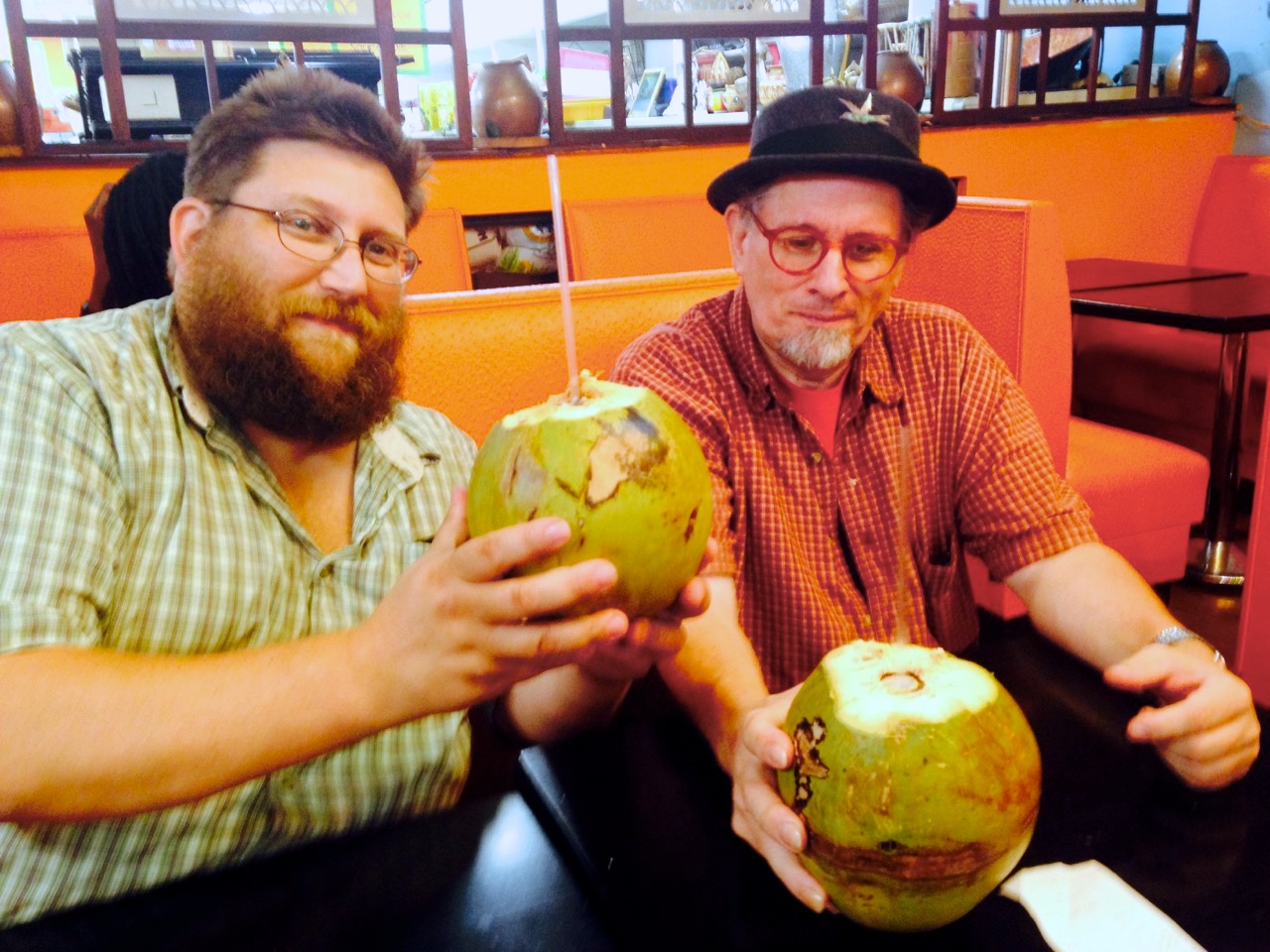
Perfect weather and easy driving put us in Cambridge a few hours early and I peeled off to a coffee house while Jesse stayed with the gear. Jesse's friend, the guitarist Glenn Jones, met us for dinner at the Dosa Factory, an Indian restaurant and grocery store brimming with personality. Glenn bought us some absurd coconut water drinks served in the actual coconuts and we caught up with him over dosas and dahl. We told Glenn the story of thinking we'd played poorly at the Spotty Dog and then reviewing the tape and realizing that the music was actually good. He nodded and recounted how Immortality Lessons, one of my favorite Cul De Sac albums, had been recorded in a rushed session under less than ideal circumstances at a radio station at Brandeis University. He came away from it thinking it was a wash, but after reviewing the tape later was surprised to hear that it was actually excellent. It's an album that mixes droney structures and improvisation with a strong sense of continuity and a quality of patient, coherent development that travels lucidly from one sonic destination to another.
We headed over to the venue, Mobius, a one-room gallery space a block away and went into standard pre-gig fussing and futzing mode. Matthew Azevedo, who had both booked the gig that night and mastered our cassette, was opening for us in his electric music incarnation, Retribution Body. We started helping him load in and I became alarmed at the size and weight of the cases we were carrying. He proceeded to assemble a massive tower of speakers and amps going all the way up to the ceiling in an arrangement that looked like a combination of Stonehenge and a 1970s Dr. Who prop.
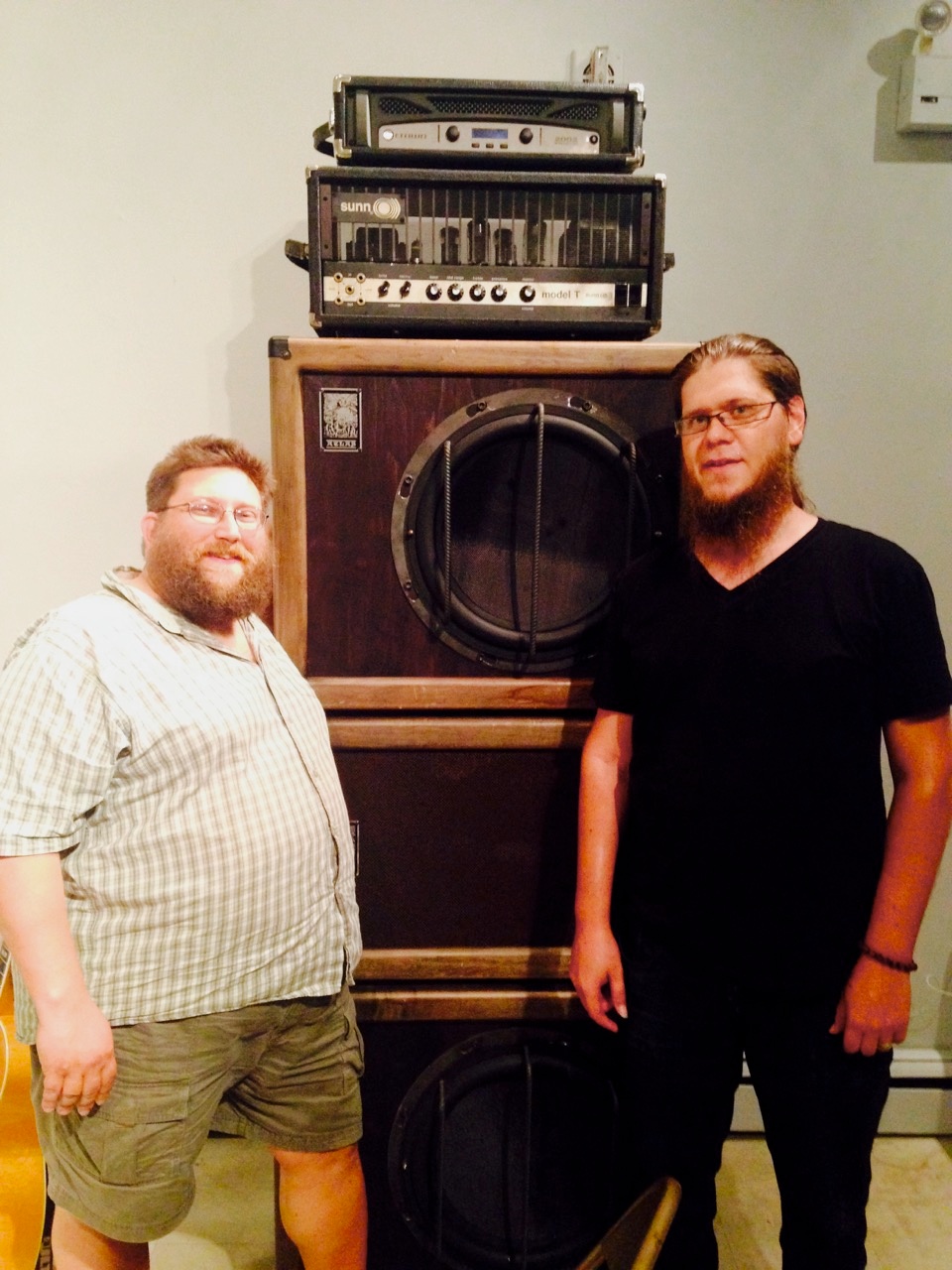
With a small but attentive audience in their seats Matt fired up his portable modular synthesizer and started patching and twisting knobs to create sound textures. He would slowly sweep through pitches and find particular sympathetic vibrations in the room to rattle a door or vent or create standing waves that moved blocks of air back and forth through the open door. The music sounded like a rockslide, then it would transform into an alien abduction soundtrack, then into a graceful but monstrous deep-sea tableaux. It felt like we were breathing sound. I suddenly understood why it was worthwhile to set up all this outrageously heavy gear. Occasional glances outside the door to alarmed passersby revealed some interestingly confused faces.
Our set went well and it was great to have Matt sit in on harmonium for our last tune, "Harlem Raga." As all three of us faded out at the end of the set the sound of a car alarm could be heard calling back to us from the street beyond the venue's open door.
The ride from Boston to Providence that night to stay with Matt included an unbelievably heavy rainstorm that reduced visibility to nearly zero, with just the tiny, blurry dots of orange tail lights to give us any context for the highway or the space around us. The deluge of rain sounded like five Sunny Murrays playing drums at the same time on the car's roof. Matt and his wife Karen greeted us at their newly acquired Victorian home with pizza and cats. Lots of cats. We were warned that incontinent cats might try to rest on our heads as we slept, a problem I solved by taking the floor in Matt's mastering studio behind a locked door, my feet nestled up against his towering array of bass cabinets.
Brooklyn, NY – Pete's Candy Store
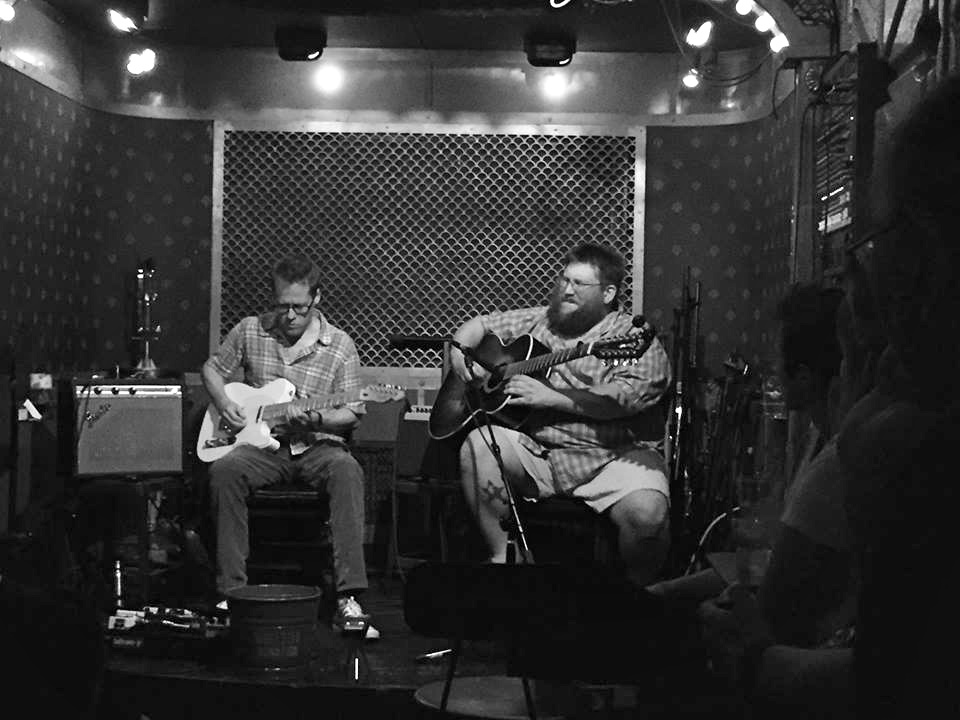
The acoustic finger style technique Jesse uses is usually played quietly, and the electric style I use is usually played loudly, so the mixing of these styles sometimes presents challenges. For the tour Jesse amplified his acoustic 12-string Guilds with active L R Baggs undersaddle pickups through a Fishman amp, but our volume level was still capped by his guitar because he likes to mix a mic with the pickup to get the right sparkle from the high end of the acoustic. Basically I come down to his volume, and as time has gone by I've used tube amps with lower and lower wattage to get the right growl out of them, finally settling on a six watt 70s Champ as the ideal. Our loudest volume is fairly low, but you don't have to play loud to rock. However, playing quietly means that bars with people talking loudly are not always workable environments for us.
Pete's Candy Store in Brooklyn was one of our two home-turf gigs on the tour. Pete's is a bar, but it has a music room in back that's isolated from the general bar noise, so it works well for us. And the room has a particular vibe to it, like a film set or a vintage train car. The venue is easy to get to from different parts of the city, the people running it are friendly, and we like playing there in spite of the fact that they're pushing through as many acoustic singer songwriters per night as they can. I could tell early on just from the vibe on the street outside the bar that this gig was going be a good one in same the way I can tell a storm is coming from the way the winds moves the leaves on the trees.
Dominique and Mike, who run Beyond Beyond is Beyond, came by early to grab a drink before the show and it was great to meet them in person. They are lovely people running a really awesome label. We discussed the idea of Elkhorn having one foot in psych-rock and the other in folk/experimental and decided it was pretty irrelevant what you called it as long as it was honest.
After a quick sound check we were ready to hit. The back room filled up to capacity and beyond quickly. With a house packed full of relaxed, supportive friends it's pretty easy to have a good gig and that's exactly what we did—one of the best on the tour—executing the songs well and going deep into the improvisation/drone passages. We ending with our heaviest rocker "Earthbound," which we had never played live before, and it worked well. The extended guitar flip-out at the end felt great. We moved a lot of merch to boot, but the Elkhorn supply chain management system still had room for improvement because we started to run out of t-shirts by the 3rd gig. This is a good kind of problem to have though.
After a few hours of post-gig conversation we headed back up to my apartment in Harlem for a good night's rest.
Highland Park, NJ – Pino's
I took the next morning to relax and get a bit of work done at home while Jesse met up with his daughter, Eva, and stepmother, Maarit, at the Metropolitan Museum of Art. A little after lunch we got back on the road and drove through the familiar I-95 corridor of North Jersey, with its exponentially proliferating highway lanes, flaming oil refinery towers, and commercial aircraft turning at crazy angles over the industrialized marshlands. This was the landscape of our youth.
We met our old friend Amy Jacob at her father's idyllic house not far from New Brunswick. The weather was perfect and we had some time to hang out with her and her twin boys, Doot and Bing, by her dad's pool—a rare chance to truly relax before a gig. Amy was the singer in Mayfirst, the late 1980s New Jersey high school band in which Jesse and I played bass and drums respectively. Amy went on to marry the guitarist of the band, our old friend Alex Saville. The two of them became the nucleus of Prosolar Mechanics, one of the biggest bands in New Brunswick during the 1990s. Tonight's gig was a kind of Mayfirst reunion with Elkhorn opening for Prosolar, who were doing a duo set. By the pool, Amy regaled us with some epic '90s Prosolar road stories, and we talked about her newest creative outlet as an author of indie rock-themed romance novels.
Back in Highland Park we did a quick practice in Amy and Alex's basement surrounded by their impressive collection of guitar amps, and worked out a quick take on "Unrelenting Hate," an old Mayfirst song featuring appropriated lyrics from the Campuchian national anthem. It was promising, but we didn't have nearly enough time to flesh it out.
Pino's was a wine store that had been bought by a local musician and expanded to include a neighborhood tavern and venue. It looked like it was still in transition, but there was something very comforting about the place—perhaps emanating from the friendly owner, Stephen Weinstein. There was a fairly roomy stage area in the back surrounded by odd, dormant interstitial geometries of still un-repurposed space. We did a quick sound check and caught up with a few old high school friends who had shown up early. As we started the set I realized that there was going to be a lot of chatter coming at us from the bar in the other room while we played. I had spent most of the early 1990s as a jazz drummer, and was familiar with the vibe—it was like a standards gig— tune out the audience, focus entirely on the music and play the best set I possibly can. With this approach, an inattentive audience disappears when you start playing and reappears when you stop. No problem. Jesse tried to deal with the situation by playing at an ever-increasing tempo, hoping that this would somehow capture the audience's attention, but of course it had no such effect. On the song "Ohun" the comically fast pace made the song sound like prog rock.
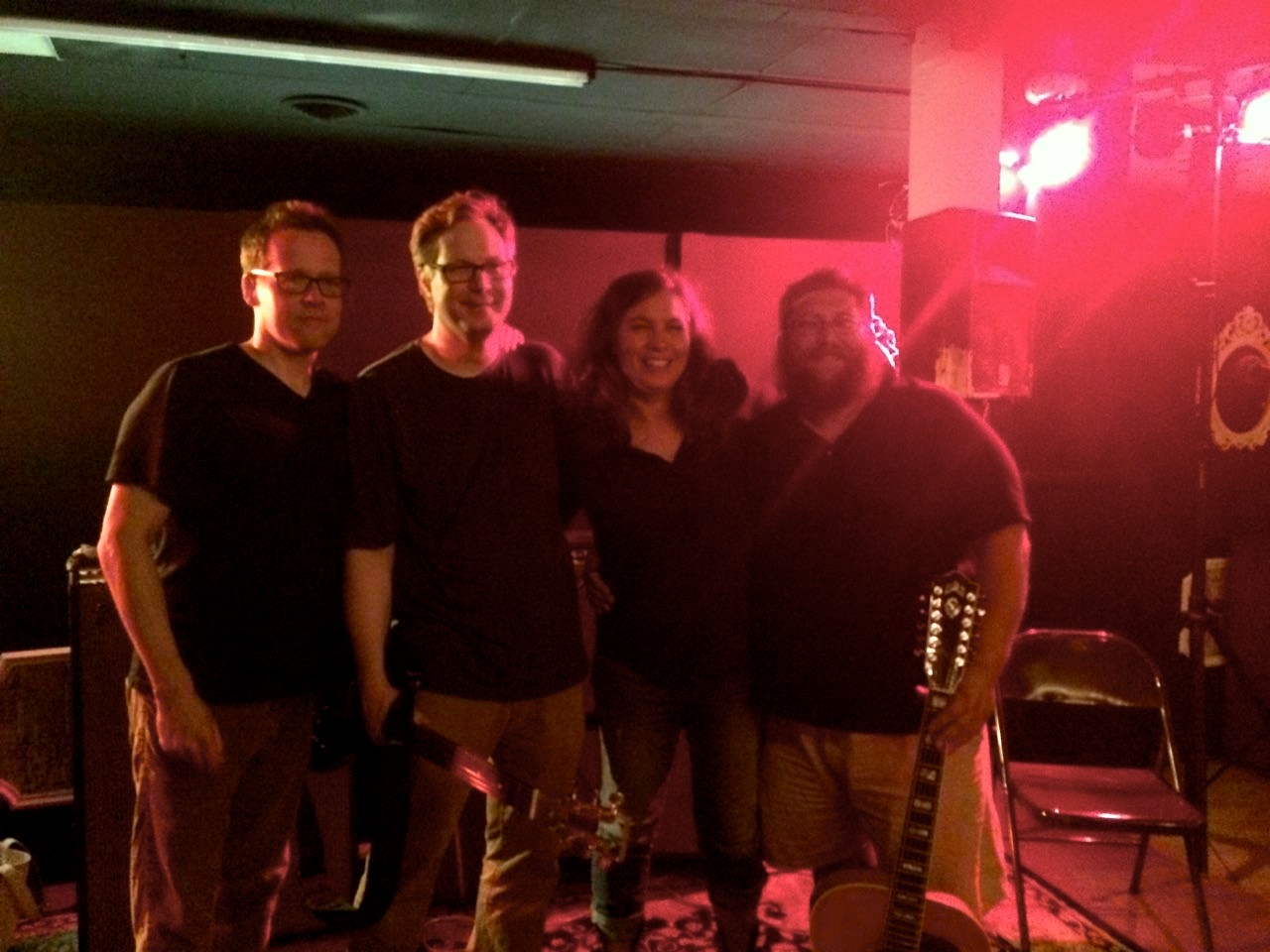
This was the first time Amy and Alex had played in a guitar duo format. Even though I could see they were uncomfortable with the low volume and lack of undergirding from a drummer and bass player, it worked well. The depth, clarity, and chiminess of their guitars really shined, and left extra room in the mix for Amy's vocals. Plus they did a great Outfield cover. Duo guitar can sound like a whole band when played and arranged in the right way.
For the last number we played our messy "Unrelenting Hate" and it felt fantastic to be on stage with these three people again irrespective of how well the tune came off. After the gig we went back to Amy and Alex's and talked into the night like high schoolers without kids, mortgages, work the next day, or really anything else to care about beyond our creative passions.
Washington, DC – Red Onion Records
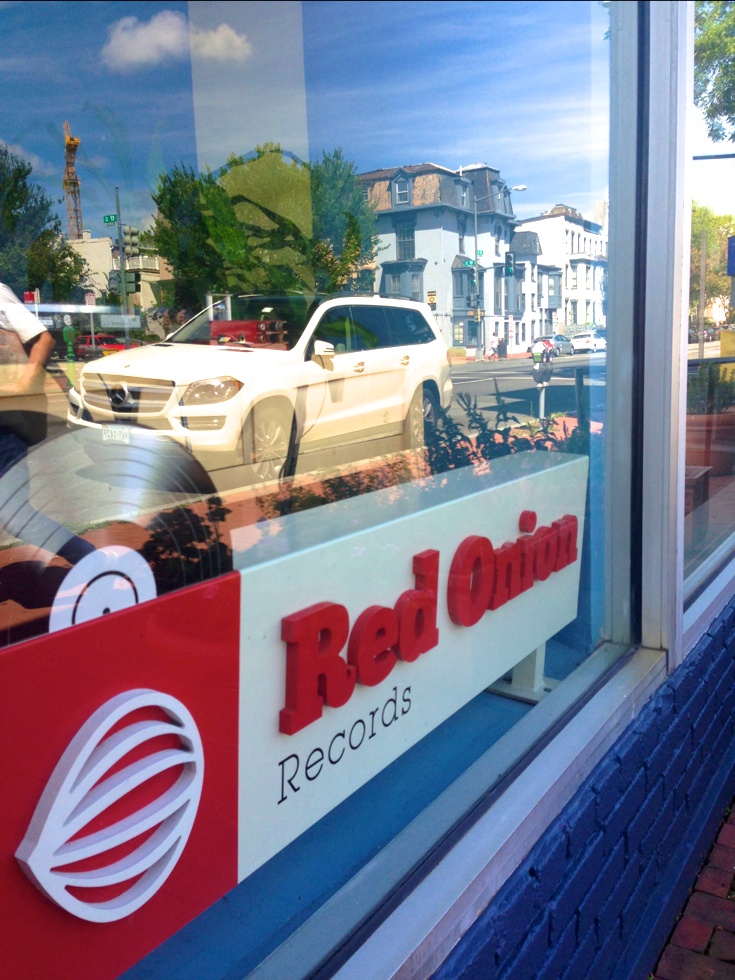
The drive from New Brunswick to DC was our longest of the tour, but all was smooth sailing. The album in the CD player of Jesse's car was Ernie Graham's eponymous solo from 1971, so every time we'd unplug our ipods Ernie would be there to give us a mellow, groovy welcome. It became our official Elkhorn tour album—great music for all road conditions. Down to DC Jesse took the first half of the DJ duties and spun some great James Elkington & Nathan Salsburg duo stuff as well as the new Ryley Walker. The arrangements on the Walker sounded to me like late Talk Talk, which I love. As we got closer to DC I took over the Subaru DJing and exposed Jesse to Joanna Newsom's first Drag City album The Milk-Eyed Mender, mostly to see what he thought of the harp tone and voicings. I love this album, but her vocals are decidedly not for everyone. He listened for as long as he could before informing me that he wanted to shoot a bolt from the medieval crossbow he had seen at the Met the day before through her eye. I cued up Walt Dickerson's vibraphone/bass duo album Tell Us Only The Beautiful Things, then Alice Coltrane's A Monastic Trio. The sequence perfectly blended with the textures of interstate foliage and the blurred surfaces of roadside sound barrier walls.
Once we got into DC we found a parking spot directly outside Red Onion Records and went in to meet Josh, the proprietor. He was friendly, helpful, and highly informed about music. We had made such good time on the drive down that we now had several hours of downtime, so we went around the corner to the Three Fifty Bakery, where we fueled up on some potent ice lattes. There's surprising little time to read on a tour comprised of back-to-back gigs, and I was glad to have a few hours to myself with a strong cup of coffee to sink into the Charlie Patton chapter of Robert Palmer's Deep Blues, one of the best books on Mississippi Delta-to-Chicago blues history out there. Through the window I could see Jesse enacting the ritual of finger style guitarist nail maintenance. This sacrament involved at least two major components: super glue and intense mental focus. Other than that, it's a complete mystery to me.
We returned to the store and I tried to stay away from well-curated vinyl selection, since a record binge here could easily eat through my tour budget. Jesse showed no such discipline. We set up and I plugged in. The old wiring in the building sent a grouchy sixty-cycle hum flowing through my guitar. This is the downside of the Telecaster's vivid single coil pickups. With old wiring I have to turn the angle of the guitar relative to the room's magnetic fields to mute the hum. I rotated around slowly, and the perfect silent angle proved to be just at the point where I was sitting with my back to the audience, facing a potted plant. I turned around and did the best I could by riding the guitar's volume pot with my pinkie to mute out the hum during quiet sections. At times like this I try to remember that it was my free choice to use electricity to make music.
The crowd was lively and receptive and we had a good set. Merch sales were solid with Josh running the table. It was great to see family and friends from different aspects of our lives mingling with DC music heads of the first order. Great vibes all around. Afterward it was still early so we hit the town: Jesse going to see Jackie Lynn with his friend, drummer Ian McColm… and I hitting a bar with some friends from the poetry scene who had come to the gig. Later Jesse and I ended up at a diner with my friends Rod Smith and Mel Nichols. The server at the diner seemed openly hostile to the idea of bringing us the food we had ordered. We crashed on adjoining couches at Mel's nice digs in Cathedral Heights.
Wilmington, DE – Between Books
Our Wilmington show was a fifteen-minute drive from Jesse's house in Chadds Ford Pennsylvania, and this set reminded me of how much easier it is to play a show when you don't have to do several hours of driving first. On the way there I was a little disoriented from a moment of diabetic low blood sugar in the Wawa parking lot and almost got into the wrong car—one owned by an elderly Chinese gentleman whose car looked exactly like Jesse's. He had a look of intense fear on his face as I opened the passenger side door. I think for a moment he thought it was a car jacking.
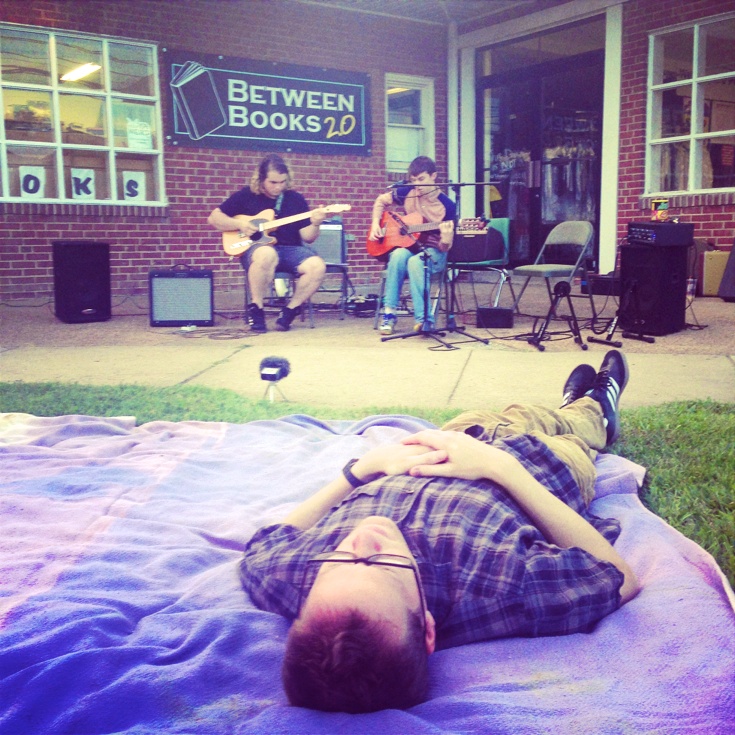
That evening's venue was a Sci-fi/Fantasy bookstore, Between Books, perched along a desolate strip of the Philadelphia Pike between a Dunkin' Donuts and a discount liquor outlet. We were playing outside the bookstore, setting up in front of the glass side doors of an adjoined dry cleaning establishment and playing to an audience of teenagers, friends, family, and local characters scattered on lawn chairs and blankets across the sidewalk with traffic swishing past behind them.
The proprietor of the bookstore, Greg Schauer, was a mild-mannered Tolkienesque figure in his mid-fifties sporting a long graying beard and a pipe. A quick look through his store revealed a stock of half-priced sci-fi, fantasy, graphic novel, and manga publications so extensive, specialized, and over my head that I quickly stopped trying to understand it and just drank it in the way a dazed tourist would drink in the foliage in a strange forest. Apparently what's in the store is a fraction of what Greg has in storage.
Opening for us was Jesse's seventeen-year-old son Eli, playing acoustic guitar and doing all-original material in a duo format with friend Zach on electric guitar. Eli writes excellent songs that sound like a curiously self-effacing mixture of Pavement and Sparklehorse. His delivery and stagecraft comes off as pretty low-key, but the quality of his material is great, especially considering he's only seventeen. After Eli's set I stretched out on blanket and immediately sank into a deep sleep, my body eager to chip away at the sleep deprivation already incurred by the tour. Jesse's wife, Ina, looked at me with a slightly alarmed expression and asked "Is he okay?"
Playing second was Jonathan Cooney doing a solo version of his band No Stranger. He performed technically perfect emo-style pop in the vein of Sufjan Stevens, and provided a good counterpoint to Eli. Neither of the opening bands had much of a connection to our music, but it was nice to see a gaggle of teens drifting around at the edge of the show and in the bookstore.
Playing amplified music outside never sounds quite right to me. It gets swallowed up by the air. The sounds reflecting off of walls and ceilings are part of what music is addressing—constructed social spaces. I like playing outside despite this, because looking up at the jagged, rippling clouds for some reason helps my soloing. We did a tight set and finished with a trio version of "Earthbound" with Jesse's friend Tyler Dill, who was sitting in as second lead—the sound of wailing guitars and rushing cars ascending into the clear night. As we placed the last guitar case in the car it began to rain.
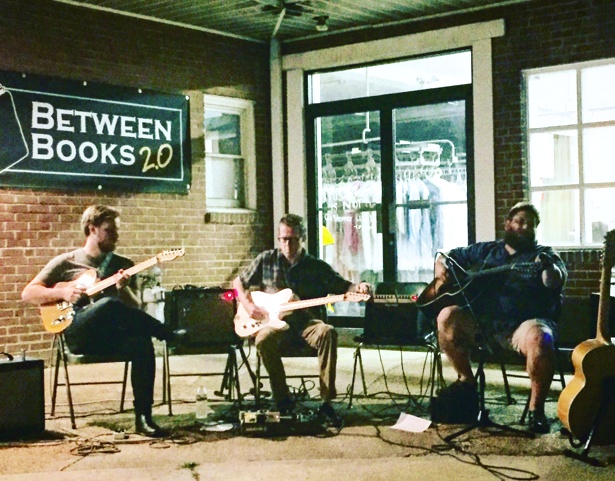
Philadelphia, PA – Random Tea Room
Philadelphia's Northern Liberties neighborhood has a peaceful emptiness to it, like a ghost town, but in a good way. Unloading the gear from the Subaru's hatchback I watched the clouds above the power lines run in orange and pink streaks and saw through a first-story window the section of a stranger's cat scratching post. You see many small fragments of other people's lives on tour.
Stepping into the front room of the Random Tea Room, you enter Becky's world: intimately tight quarters and the air filled with incredible spices, art on every available surface, odd tea implements for sale, and bottles and jars of potions and ingredients stowed away in various nooks like a medieval apothecary. The chai tea sweet with a thick milky body and a complex set of aromatic spices, cardamom, ginger—incredible—and I don't even normally drink tea. As the evening went on I kept returning to the counter to talk to Becky and pick her brain about how she makes the stuff and try as many different teas as possible. Looking back at me from the walls were dozens of David Bowies. A local outsider artist had been working on these drawings over many years, each one from a different era of Bowie. Having this many David Bowies staring at you from the walls before a gig must have some impact on the music.
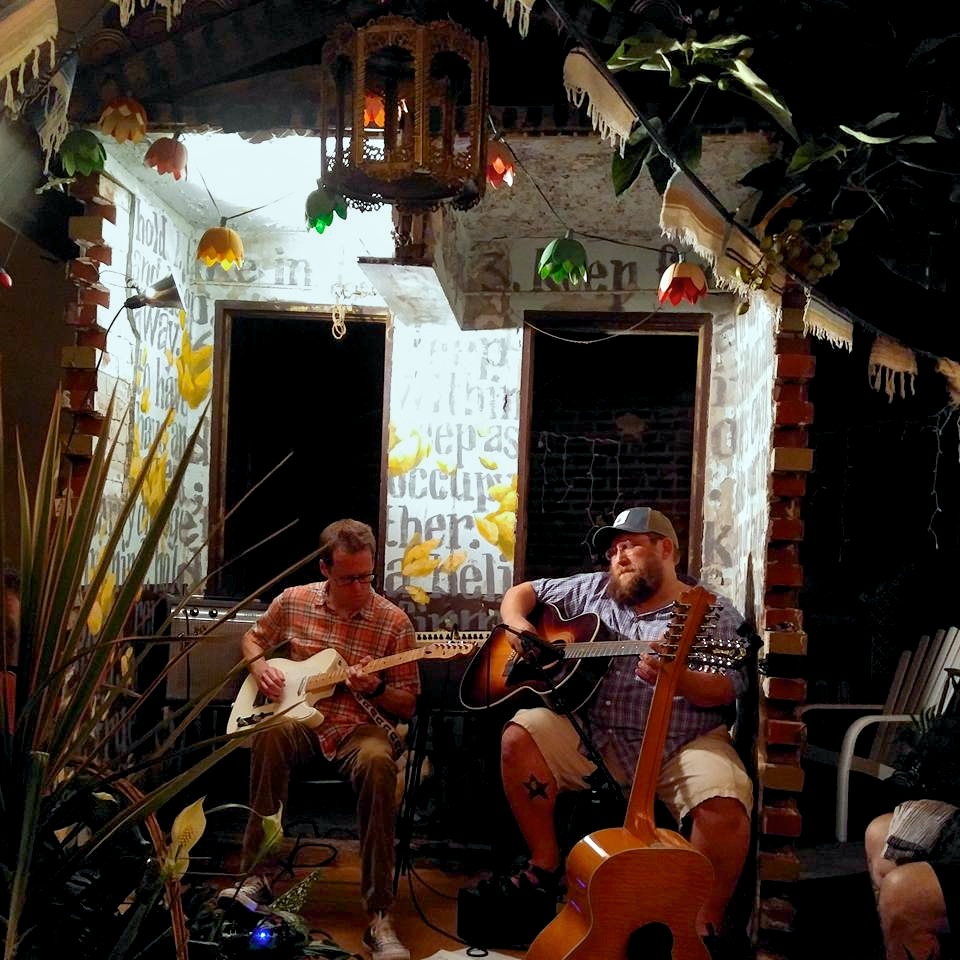
This was our second hometown gig of the tour since Jesse lives nearby and spends a fair amount of time in Philly seeing music. We've had several great shows at the Tea Room, playing with fantastic bands like 75 Dollar Bill and Grex. When the weather permits, the performance space is outside in a surprisingly rustic courtyard with a tiny stage in the back half of what used to be an outhouse. A massive tree hangs above the stage, which is beautifully painted and adorned with lights. On a beautiful summer night with the sound of the city coming over the walls, it is one of the best music venues in Philadelphia.
This was a night of guitar music. Andy McLeod opened. He was in top form, with his set featuring note-perfect renditions of Elizabeth Cotton and Jack Rose. Andy's music mixed beautifully with the cicadas and a huge leaf fell at his feet as he played. This was also our first show with Jerry Hionis opening on solo twelve-string. He would be playing with us over the next few dates, but he only did his great version of No Quarter at the Tea Room. By the time Elkhorn hit, the place was pretty full with a good mix of family, friends, and walk-ins. It was great to see that some of Philly's music cognoscenti had shown up to see us. There were even a few ears up on the roof above us. But the most memorable audience member was certainly Jesse's mother's friend Michael, who wore a white silk jacket to go with his colorful kofia, and spent the entire show engaging in a form of heckling so good-natured that it actually became a conversation between Michael and each performer—an ongoing commentary on the music. We had a great set, another opportunity to channel clouds into my playing. Afterward, as the merch dwindled, I talked with a young couple who happened to hear us from the window of an airbnb upstairs and came down to enjoy the music. This was the second night in a row that it began to pour just as we finished packing our gear. Good tour karma.
Harrisburg, PA – The MakeSpace
After a quick dip in Jesse's pool we said goodbye to Ina and Iggy, their black sheepdog, and drove west. We got into town early and went straight to the venue to load in. The MakesSpace is a rowhouse just beyond a small commercial strip not too far from downtown Harrisburg. The houses on either side have front porches piled up with cracked toilets, cardboard boxes, and filthy broken toys visible through the gaps in the railings. It's porch-based, post-industrial, permanent recession installation art. The MakeSpace itself is a rough-hewn gallery space, with interior walls intentionally torn up—old housing stock with its mucus membranes pulled out and its organs showing. The art on the walls was fun and interesting. Mostly collages of varying dimensions, including one artist who worked with plastic doll parts and spray paint. There's a small area to perform in front of the bay windows facing the street.
We set up and did a quick sound check for our host Mikey Rioux, a dancer and visual artist who had moved to Harrisburg from Chicago a few years earlier. After that, there was time to kill so we headed off to the Midtown Scholar, a massive bookstore that used to be a movie theater. Glenn Jones had mentioned to us that this was a place worth checking out, and it did not disappoint. It had a shocking amount of floor space—retail book geography you become unaccustomed to after living in New York City. I stuck with my no shopping rule, but a quick scan through the enormous poetry section revealed the quality of the stock, including several old Sun and Moon Rae Armantrout books at reasonable prices. In typical fashion, Jesse found a book on prehistoric shamanism. Downstairs in the coffee shop I struck up a conversation with an old blind diabetic man. Asked him how his A1C was and we talked about his service dog and other stuff for a while. I picked the brain of the barista about where the good food in town was and she said it was "gallery day" (the 3rd In The Burg monthly art festival) and pointed us toward a parking lot featuring several food trucks. We went with the BBQ and it turned out they were serious about what they were doing. Great pulled-pork sandwiches and slaw which we ate sitting on the grass watching families walk around calmly in the perfect late-summer air.
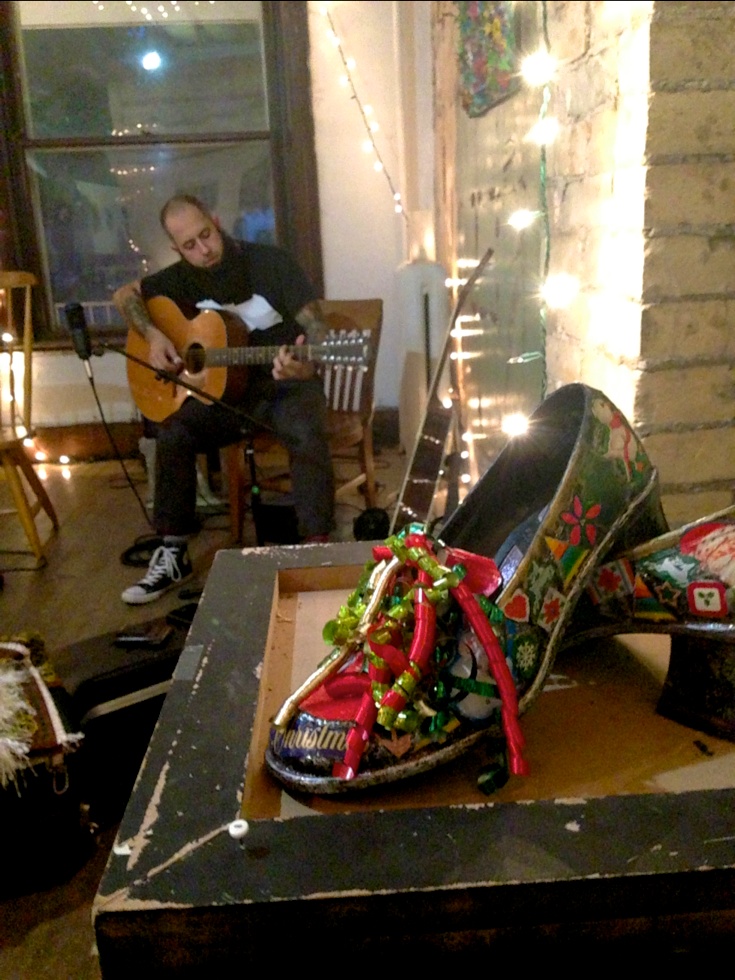
Back at the gallery it was time to play but the place was empty. We pushed start time back a half hour and I walked over to the gritty bar across the street to get some beer. The bar, called The Uptown Café, was in what appeared to be a dilapidated abandoned building. The signage on the bar was posted over boarded-up windows in the front. The place looked like something out of a documentary about urban blight. And yet, it turned out to be a great bar. Every single person in there was a character, and the air was a thick fog of cigarette smoke and incense. I immediately got into an engrossing conversation about early Funkadelic with a young African American couple. A half hour later I grabbed a five-dollar six-pack and went back to the gallery. A small audience had assembled. The room sound was good and we had a very relaxed set, calling the songs as we went. During the opener "Ohun" we hit a deep jam that almost felt more like the interaction between Jesse and I when he's on bass and I'm on drums—comfortable and flowing. Then we realized we had forgotten to hit record on the digital audio recorder we had been using to document each set.
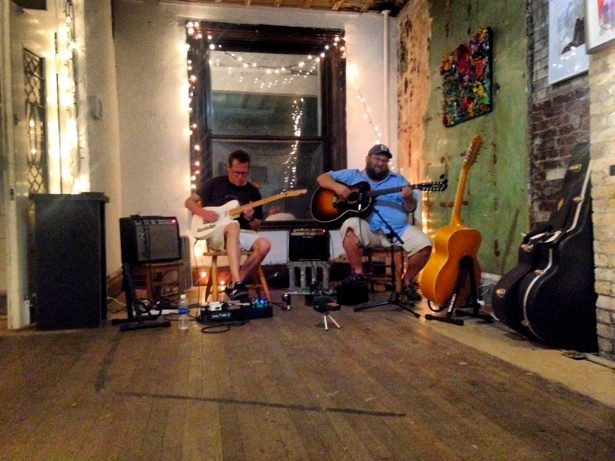
Mikey put us up. He had a fairly domesticated bohemian house a few blocks away from the gallery. His fiancé, Heather, who runs the gallery with him was away for the weekend. Unloading the car in a space overlooking an empty lot, I saw the stark outline of a stray cat temporarily frozen in blue-gray moonlight. We laid on the floor in the living room and played records and talked with Mikey and his friend Misha—friendly, interesting people. Some country blues by John Henry Barbee took a spin, as did one of my favorite records – Issac Hayes' Hot Buttered Soul. But Mikey's Hendrix in Maui 1970 bootleg on clear yellow vinyl was the highlight of the evening.
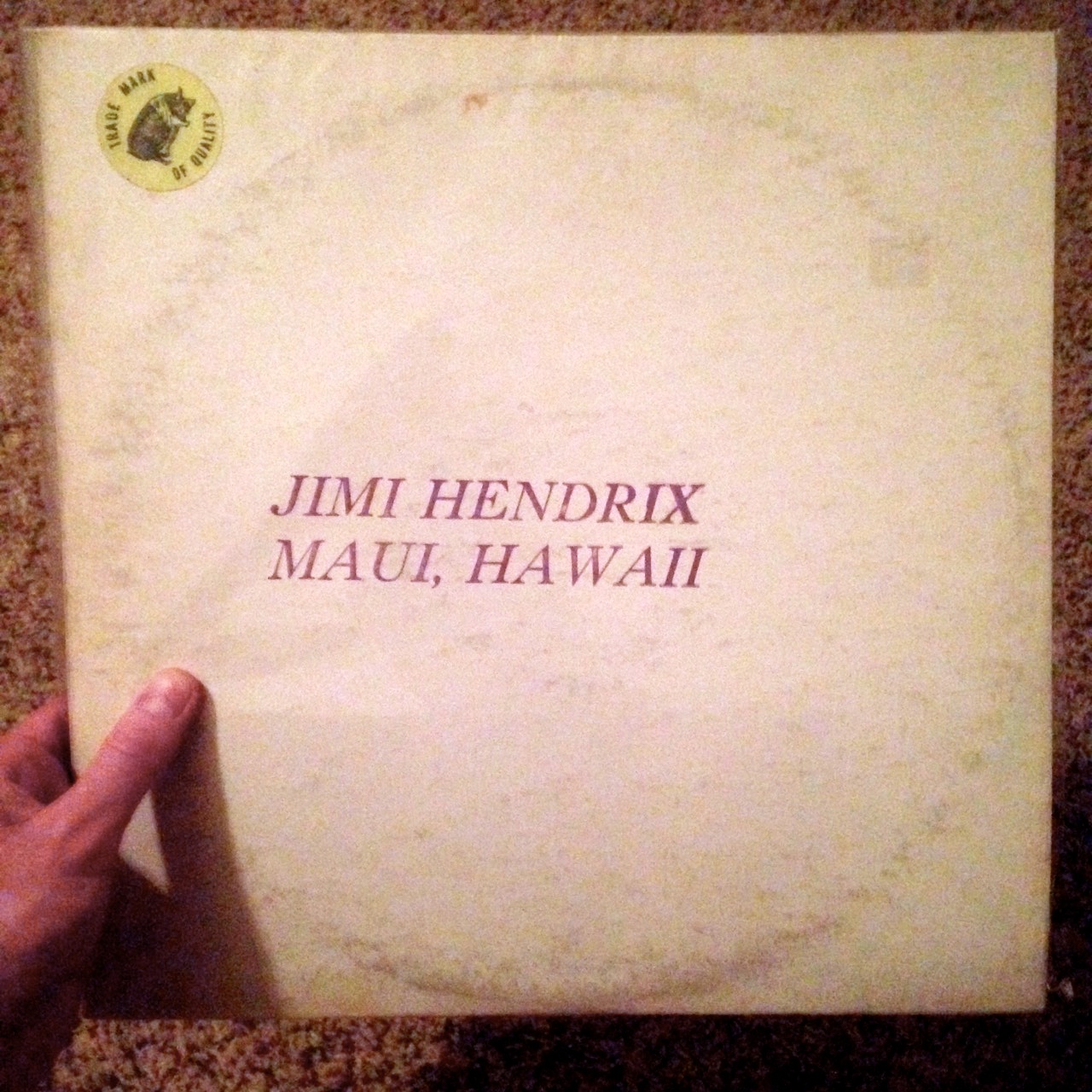

Pittsburgh, PA – Acoustic Music Works – Saturday, August 20th
We took Mikey out to breakfast the next morning at a great hole-in-the-wall diner and went for a short walk down by the banks of the Susquehanna River before loading up and heading west. The Squirrel Hill section of Pittsburgh is all rolling hills and low brick buildings. We got there early, loaded into Acoustic Music Works, found parking, and walked around the neighborhood to kill time. The first stop was Jerry's Records, a huge 2nd floor field of vinyl a few doors down from the venue. I managed to stay in window-shopping mode again but going through the bins has its own kind of pleasure, like walking through an orchard. Jesse said things looked a bit picked over for what he was into, so we headed out and got some Vietnamese beef salad up the street that was so hot I was sweating by the end of the meal. This nicely reset my brain for the gig.
I could sense pretty quickly that Acoustic Music Works was an important hub for acoustic guitar players in the area—the patina on the place, the carefully curated vintage guitars hanging on the walls, the way the workshop spaces were laid out. These people were serious. Raymond Morin, the in-house luthier and booking agent, greeted us as we came in. Ray had an extreme sports level of knowledge about acoustic guitars and acoustic guitar music, which would leak out in bits as the evening went on.
We set up and sound checked and I immediately heard a reverb signature in the room that was totally unique: our music reflecting off and through the resonating sound holes of dozens of acoustic guitars hanging up on every available surface around us. Acoustic Music Works as a venue is mostly for traditional solo acoustic and singer-songwriters, and after the sound check Ray pointed out that mine was the first wah-wah pedal to have ever been played in the store. I took a certain pride in this.
Oddly enough my girlfriend, Katie, showed up at this show because she was in town visiting her uncle and aunt and cousin and his wife, who all live in Pittsburgh. Elizabeth Fein opened with some focused nerd-folk in the Magnetic Fields vein. Then Jerry performed another killer set of traditional finger style with prog-metal implications. His John Carpenter tribute piece got better and heavier each night he played. He and his wife Dorothy are such cool people and Jerry is a great blend of focused discipline with easy-going mellowness.

The crowd was good and we played a strong set leaning on the folkier material. Ray looked on from his position of authority behind the sales counter. I wasn't sure how Katie's presence would affect my playing. Some players show off or clench in the presence of their significant others. In my case having Katie there gave me an increased feeling of freedom, and I laid down one of the best versions of the tune "Due West," which had been eluding me throughout tour. Then we realized that we'd forgotten to hit record again.
Ray was putting us up, so after the gig we went back to his place and hung out. He and Jesse had a lot to talk about since they've both been steeping in the tea of the solo guitar scene for a very long time. Looking around the house it became clear that Ray lives what appears to be a perfect existence. All he thinks about are his beautiful family and guitars and music. Everywhere he goes he's surrounded by incredible, high-end guitars. Sitting around his dining room table with Ray and his friend and fellow luthier, Adam, we passed around a used late model Sunburst Collings CJ-35 with Sitka top and Mahogany back and sides that he had used on the latest album by his band, Pairdown. It had a warm, mellow tone and was incredibly comfortable while still having a little fight in it. The more I played it the better it sounded, and it had a gradual but powerful magnetic pull on me.
Columbus, OH – It Looks Like It's Open
With Jesse deeply unconscious in the passenger seat from many days of sleep deprivation and a long dull stretch of I-70 in front of me, I decided to explore the local radio of eastern Ohio. I bypassed the classic rock stations playing Eagles tunes and quickly hit the jackpot: a creationist radio show meant for children. The narrator character was a tiger who would explain certain select "wonders" of the natural world in the unmistakably patronizing tone of an adult reading a bedtime fable to a child. He explained that Jesus was the "master designer" of the universe. It turns out that this rabbi who lived two thousand years ago designed the jaws of tigers so as to perfectly crush the windpipes of gazelles and immediately sever the spinal cord so their prey would never feel any pain when they fulfilled Jesus The Master Designer's plan and became one day's lunch for a predator. Ohio seems to have ample ideological space for this type of cheery and entertaining disinformation.
We arrived in Columbus and checked into the Holiday Inn Express that had been booked for us. The music series we were playing is called "Song for the Owl Concerts" after a Jack Rose tune. This was our first and only hotel room of the tour. We took a couple of hours to practice, write the set list, fight over whether we should watch Golden Girls or Naked And Afraid on TV, and generally feel like rock stars—living the dream. We then drove around the block to the venue "It Looks Like It's Open," a decidedly closed-looking yoga studio and performance space. Getting out of the car, we found ourselves standing in what appeared to be an eerily ideal suburban neighborhood: perfectly manicured lawns, perfect weather, perfectly fresh air, and a general vibe of peacefulness combined with a complete lack of discernable human activity. We loaded in and met our host, Brian Werstler, an affable, if slightly serious, music lover of the first order who runs "Songs for the Owl" as his way of supporting the avant-garde folk and experimental scene in Columbus. He showed us his Ray Morin-built acoustic guitar.
At about this time Ryan Jewell showed up. Ryan is usually on the road playing drums in Ryley Walker's band, but happened to be home in Columbus that night. He had expressed interest in our music online, so we reached out to see if he'd like to play on a tune with us for our last show. He was down to play and showed up early to say hello and rehearse. Solid dude, great musician, and possibly one of the nicest human beings on the planet.
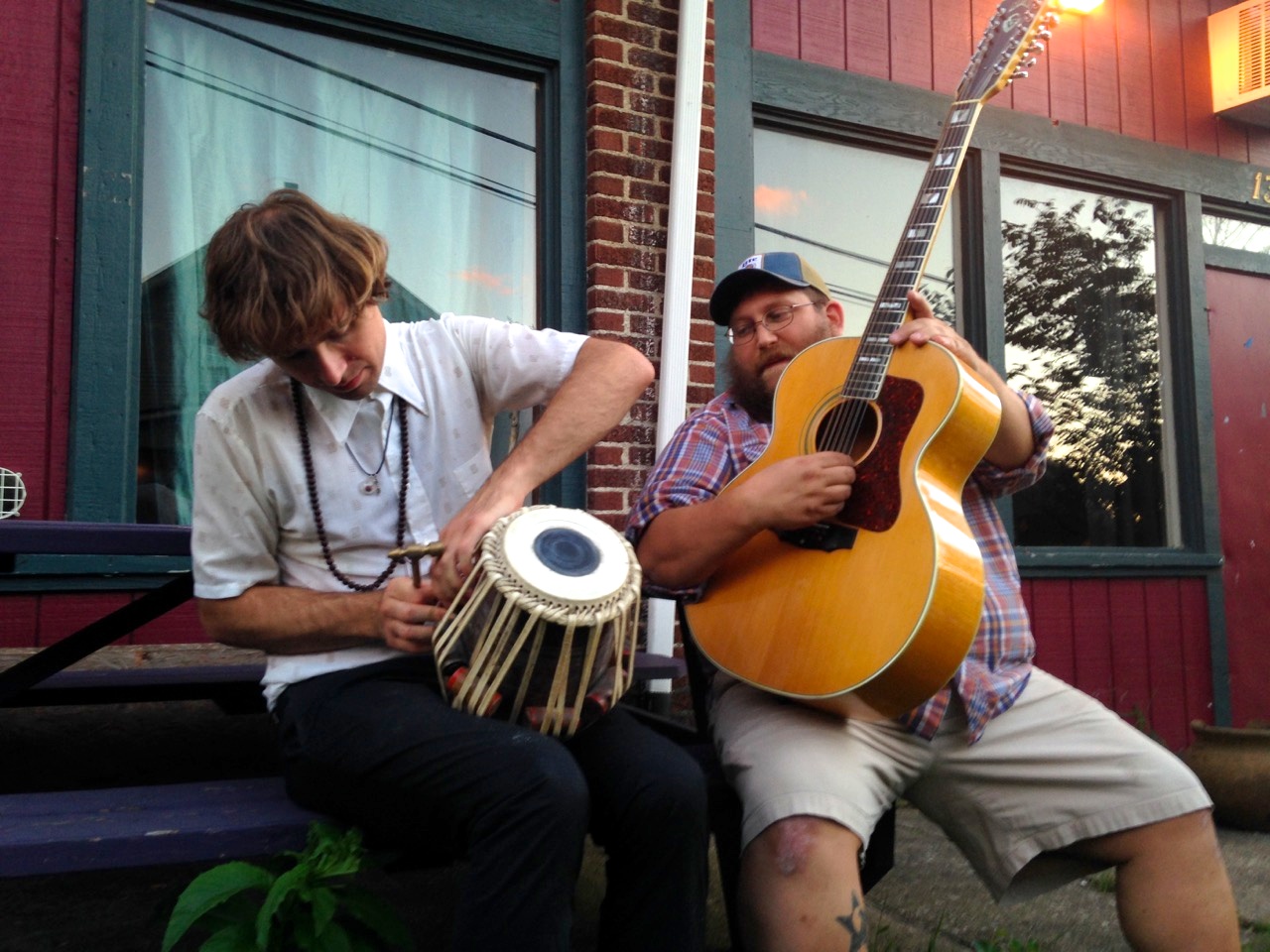
The sound check with Ryan on tabla was a little tricky because it is such a delicate instrument. We played a little and the trio sounded great. Ryan made it feel like we had an extra outboard motor on the boat. We all went into pre-show waiting around mode. Some people went out to smoke and Ryan stayed in and mediated.
It was more than a half hour past start time and it began to dawn on me that we were going to be playing only for the other bands and Ryan, no one else had shown up. I remembered a good rule that Jesse came up with: don't ask any big questions about why you're doing any of this when things don't go as expected.
Brian's duo with Eoin Bell-Games, Abgyhr, started their set. They played gradually changing ambient/noise/space guitar music with prickly but lucid textures. The minute Brian took out his electric sitar we knew we were at the right place. Istvan Medgyesi was next with an interesting set of drone-oriented finger-style solo acoustic alternating with minimalist modular synthesizer pieces. Musically, these two openers gelled with Elkhorn better than most of the other bands we'd played with—perhaps even the solo 12-string players. We delivered a solid set, though I have to admit I let the lack of an audience get to me a little. When we got to our cover of Coltrane's "Spiritual" Ryan came up to join us on tabla. He was great at sharp timekeeping while also freely filling in figures and textures delicately mixed with solid forward propulsion. If we'd had more time to practice I would have gladly had him play the whole concert.
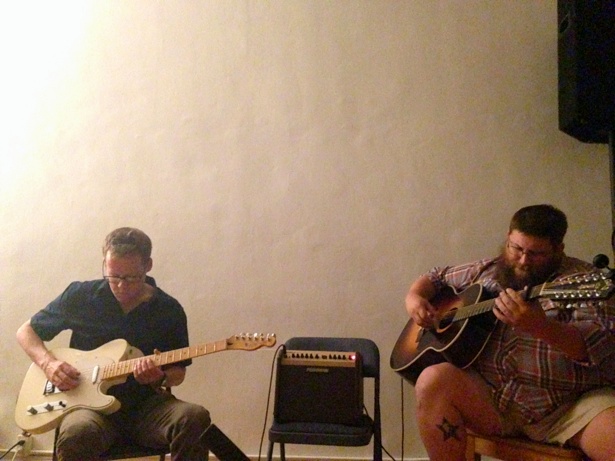
After the set we packed up and drove back to the hotel. The Columbus Holiday Inn Express felt like a scene of unthinkable splendor and comfort. We slept a deep slumber of bewildered satisfaction at the idea of what we had just accomplished.
The next day we packed up and took the long drive home.
Written by Drew Gardner Programming by Marcus Obst
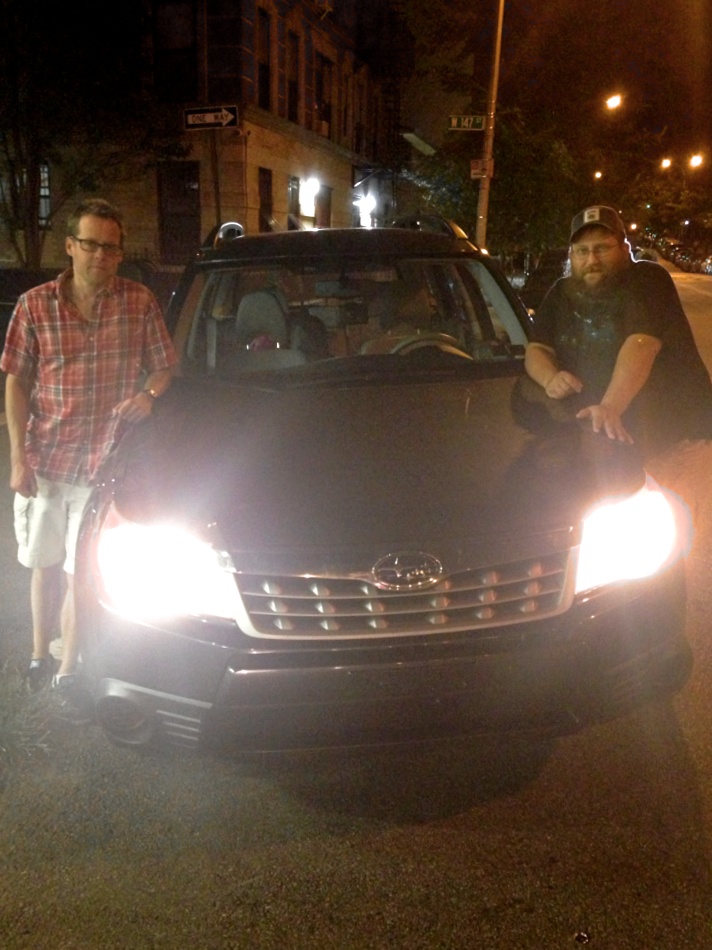

Write a comment, say something!